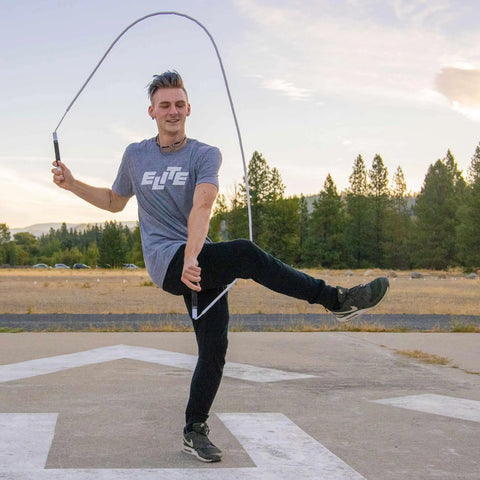Is Jump Rope a Sport? An Intro to Competitive Skipping
Sep 07, 2022Jordan Lindstrom

When you think of a jump rope, you most likely think of rhymes on the playground, or maybe a workout at the gym. What you may not imagine is athletes training for hours upon hours, elaborate gymnastics-like routines, and an Olympic future.
Competitive jump rope is an up-and-coming sport featuring thousands of athletes all around the world. Here’s everything you need to know.
Have you heard of Jump Rope for Heart? If you’ve been a student in the last 30 years, you may have watched groups of jumpers (dubbed “demonstration teams”) perform in your elementary school gym to encourage jump roping for fitness. Believe it or not, competitive jump rope began thanks to this program.

After years of performing in gyms, the Jump Rope for Heart athletes realized they could take their passion for jumping one step further. In the 1990s, they began organizing local and state competitions. In 1994, they became even more ambitious and hosted the very first World competition in Olympia, Washington.
Over the last 25 years, jump rope has become a full fledged sport. Matt Hopkins, the founder of BuyJumpRopes and a former competitive jumper and coach himself, estimates there are 125 competitive teams and 100 demonstration teams active in the United States today. These teams attend competitions hosted by not one, but two U.S. jump rope organizations: USA Jump Rope and the American Jump Rope Federation.
So what do those competitions look like?
Both organizations hold regional qualifying competitions and a cumulative national competition featuring a plethora of events. Jump rope isn’t just about speed! Here’s some information about each of the three event categories:
Anita Gable is the president of the American Jump Rope Federation (AMJRF). The organization was founded in 2018 and its first tournament was held in 2019, but Gable has been attending USA Jump Rope’s national competitions for years.
“The national competition is a higher-level event where athletes are trying to increase their scores,” she said. “If they get that top spot, the number one place, they’re automatically put on a leaderboard so they can represent the US at the international events.”
The World competition is hosted by the International Jump Rope Union (IJRU). Shaun Hamilton is the president of IJRU and was the 1999 World Champion. According to Hamilton, the last world championship was held in Norway; 1,000 athletes were in attendance representing 32 countries.


Hawkins was in attendance, and his experience highlighted the unique nature of the sport.
“It’s a rare combination of super competitive, yet supportive of all jumpers. You've got people practicing seven days a week, every day of the year, but then they turn around and share a trick or a skill with their closest competitor,” he said. “There’s a real beauty to the sport because everyone’s about promoting jump rope. They love jump rope, and they want to further jump rope.”
One way Hopkins, Gable, and Hamilton hope to further the sport is by taking it to the next competitive level: the Olympics.
If you’ve ever tuned in to the games, you probably know jump rope isn’t currently an Olympic sport. But will it someday grace your screen?
Hamilton and his colleagues hope so.
As of April 2018, jump rope has observer status at the Global Association of International Sports Federation, or GAIF, which according to Hamilton is the highest level jump rope has ever achieved.
Before jump rope can become a full member and participate in the Olympic games, though, 40 countries must recognize jump rope as a sport. It’s currently recognized by 20.
“The ultimate goal is not just the Olympics, however,” Hamilton said. “The Olympics is the highest and most recognizable multi-sport event on the planet. But once we reach the Olympics, our journey doesn’t stop.”

As a former athlete himself, Hamilton is dedicated to helping future athletes make jump rope a full-time career.
“There was not a plan for me as an athlete,” he said. “They were not looking at me and saying, ‘How are we going to help this young man be a professional at this?’”
Hamilton wants to support a wave of professionals.
“I refuse to see another generation of athletes go by,” he said, “and we do not do our very best to give them a brighter opportunity for all the sacrifices they’re making.”

In addition to supporting the athletes, Hamilton hopes to shift the general public’s perception of jump rope from an activity on the playground to a legitimate sport.
“Our sport is ubiquitous. If you had a room full of 100 people and you asked them, have you ever held a sword, a few hands would go up. If you asked if they’d ever held a jump rope, almost every hand would go up,” he said. “What does that tell you? It tells you that our activity is known, but our sport is not,” he said. “We’ve got an opportunity to talk to people, and ask them to shift from activity to sport.”

We're all about equipping and encouraging people to take on big challenges, because we know the process of doing hard things helps us grow in character and capacity.
Frequently bought together
You may also like
0 Comments
There are no comments for this article. Be the first one to leave a message!